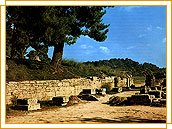Preparing and organizing the games
A set of rules, which were announced during the Olympic Games, regulated the organization of the events. Basic limitations were to non-Greeks, the slaves and women, who were forbidden to take place.  Regarding the athletes who wished to participate, they had to come to Elis a month before the games and train under the supervision of the Hellanodikai (the Greek judges). This was a kind of preliminary or practice training, during which the judges could choose those that have trained well. In addition the athletes should prove that they trained systematically in the last ten months before the games. Regarding the athletes who wished to participate, they had to come to Elis a month before the games and train under the supervision of the Hellanodikai (the Greek judges). This was a kind of preliminary or practice training, during which the judges could choose those that have trained well. In addition the athletes should prove that they trained systematically in the last ten months before the games.
When they arrived in Elis the athletes continued training. They were two Gymnasiums there where the athletes could train before the games: the Xystos for the runners and the athletes of the pentathlon and the Tetragono for wrestlers and boxers. The Gymnasium that was destined for the training of boys was named Maltho. For the training of the athletes in Elis there was also a Palaestra.
Furthermore, one of the main responsibilities of the Hellanodikai was to determine the age of the athletes that were going to take part in the games and depending on it classify them in different groups. Very young ones did not take part, while the adults could take part in men's events. Boys participated in special events that took part in the second day of the games.
Those who wished to participate and were accepted they could not resign or quit. In addition, thanks to the rule of ephedreia, those athletes that were without an opponent had the right to compete with the winner of the second round. So, the ephedros, the one who waited, had the opportunity to participate in the games.
The Hellanodikai, assisted by the alytarches (law enforcing officials), imposed to those that did not obey the rules various punishments: physical punishments, fines or even expulsion from the Games. The physical punishments were carried out by the rabdouchoi (rod-bearers) and the mastigophoroi (whip-bearers). If an athlete could not pay the fine, his city paid it for him so he would not be expelled from the games. The revenues from the fines were used to built the statues of Zeus, the Zanes, which were placed in the area of the sanctuary.
|
